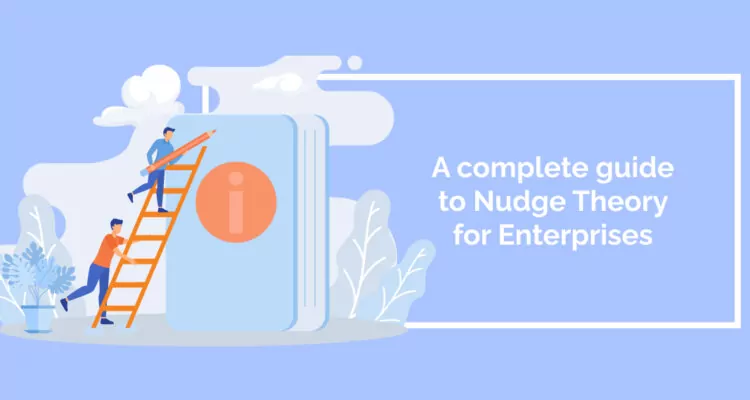
Adapting organizational structures, integrating new technologies, and revising operational strategies are more straightforward than encouraging employees to embrace these changes and follow new directives.
The key to successful change initiatives lies in understanding and motivating employees, the most critical element in this process.
Various behavior change theories and models provide us with this understanding.
One is Nudge Theory, which Richard Thaler and Cass Sunstein conceptualized in their 2008 book ‘Nudge: Improving Decisions about Health, Wealth, and Happiness’.
It highlights that by manipulating the choice architecture or the environment in which choices are made; it is possible to subtly influence people to prefer one option over another.
Through exploring this article, you will learn:
- What Nudge Theory is and its background
- The different techniques that Nudge Theory uses
- How you can apply Nudge Theory in practice
- What Nudge Theory means for change management
- The various steps you need to take to implement Nudge Theory within your enterprise
What is Nudge Theory?
Nudge theory, developed by Richard H. Thaler and Cass R. Sunstein, suggests that small, strategic alterations in how options are presented can predictably sway people’s decisions and actions.
This approach avoids coercion or altering economic incentives. Instead, it harnesses cognitive psychology and behavioral economics insights, aiming to subtly guide individuals towards specific decisions or outcomes by aligning with their natural thought processes and decision-making patterns.
A nudge is an intervention that preserves choice but gently guides individuals toward a particular decision. They subtly imply desired behaviors rather than forcefully dictating or overtly promoting them.
Nudges also aim to make the preferred actions enjoyable and engaging while being unobtrusive. They simplify decision-making processes by tapping into cognitive biases, allowing people to choose with minimal mental effort.
This gentle method of influence respects individual autonomy while guiding choices in a preferred direction. For example, “Pay now to avoid a late fee” is a nudge; it encourages a specific action without removing the option to refuse, although refusal may not be advantageous.
Origin of Nudge Theory
Before Thaler and Sunstein, nudges were often called “Libertarian Paternalism.” But the idea behind it was the same:
- Libertarian: People should be free to choose the option they want.
- Paternalism: Any attempts to influence individuals to act or behave in a particular way should be made for their greater wellbeing.
The basic tenets of nudge theory emerge when you put together these two things—freedom and guidance.
Richard Thaler, a renowned professor of Behavioral Science & Economics at the University of Chicago and the 2017 Nobel Prize winner in Economics, collaborated with Cass Sunstein, a Harvard Law School professor and director of the Program on Behavioral Economics and Public Policy, to explore this idea.
Their book posits that human decision-making is often irrational, with choices influenced more by perceived convenience than optimal outcomes due to unconscious biases.
Nudge theory suggests that rather than attempting to educate people extensively in decision-making (often impractical), it’s more effective for governments, marketers, and corporate leaders to subtly guide choices by playing to these biases.
This approach encourages healthier or more beneficial choices by utilizing the same intuitive cues that often lead to less advantageous decisions.
Building upon this theory, Nobel Laureate Daniel Kahneman’s 2011 book “Thinking, Fast And Slow” delves deeper into the cognitive processes behind decision-making.
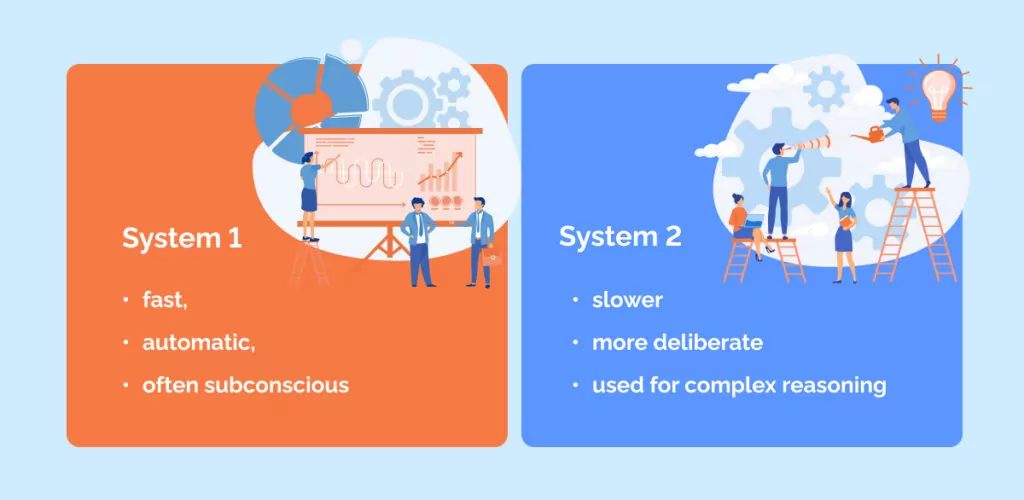
He describes two systems: System 1, which is fast, automatic, and often subconscious, and System 2, which is slower, more deliberate, and used for complex reasoning.
Nudge theory mainly targets System 1, leveraging judgmental heuristics (simple decision-making strategies) to steer decisions toward more favorable outcomes.
Heuristics are quick, often effective ways of making judgments and solving problems by focusing on the most pertinent aspects of a situation. While only sometimes the most accurate, they are typically sufficient for immediate needs, especially under conditions of uncertainty or limited information.
Thaler and Sunstein argue that by modifying the environment, nudges can guide these heuristic decisions towards better outcomes, particularly when the complexity of a situation or time constraints lead to reliance on System 1 thinking.
What are the different techniques of Nudge Theory?
Implementing nudge theory to motivate employees, customers, and business partners involves understanding and applying various tactics to encourage better decision-making.
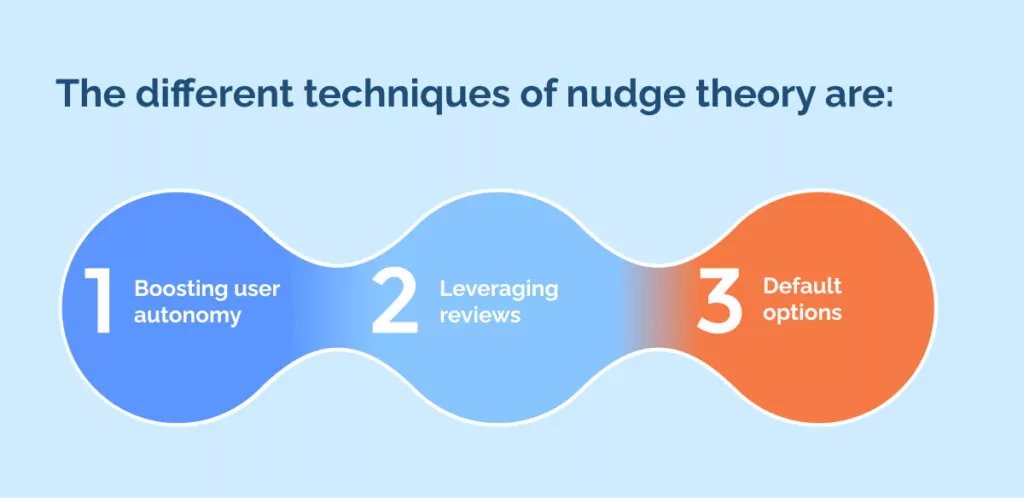
The different techniques of nudge theory are:
Boosting user autonomy
Empowering users with a sense of control over their online experience enhances the credibility of your offerings. Strive to improve on-site autonomy. This approach is practical because it presents multiple preferences without overwhelming the user with too many choices. Your nudges are situated at the crossroads of freedom and guided choice.
Consider product recommendations as an example. They offer a curated selection for the customer, fostering a sense of self-determination.
This includes language and features like:
- “Top Picks for You”
- “You Might Also Like”
- “Your Favorites”
Leveraging reviews
Reviews modify the choice architecture by providing more details about a product or service. This type of social-proof heuristics utilizes social proof to increase buying confidence and ease the typical stress of making decisions online.
In a workplace setting, starting a digital adoption process with training on new software for team leaders can similarly spread the positive influence, as it will encourage their team to look at their team leader’s behavior to guide their own.
Default options
Thaler and Sunstein’s “Nudge” describes default options as among the most influential nudges. Their power lies in their simplicity and the lack of effort required from the decision-maker.
Default options can:
- Reduce the stress of making decisions and prevent choice overload by choosing on behalf of the customer.
- Simplify decisions for users, combating inertia and indecision.
- Help customers who trust the company’s expertise to guide their choices.
- Streamline the overall customer journey, making it more efficient and user-friendly.
By strategically applying these nudge theory tactics, businesses can guide employees and partners toward more beneficial decisions and behaviors subtly and effectively, leading to improved outcomes and enhanced organizational transformation.
Practical Nudge Theory applications
Nudges work by aligning with or gently correcting our inherent and often subconscious biases, facilitating positive changes in behavior.
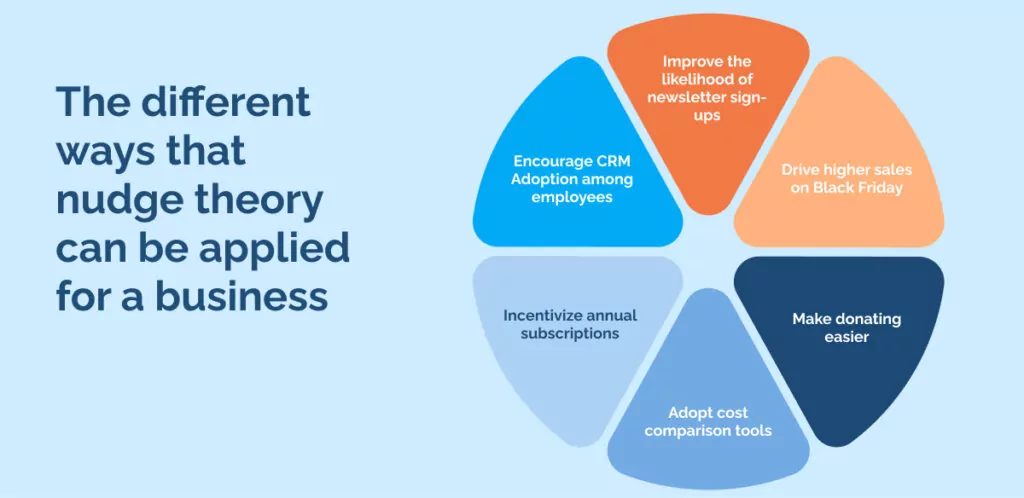
In practical terms, this can manifest in various ways:
Health and wellness nudges
- Reminders and goal-setting tools: Implement reminders in fitness apps for exercise or habit-forming apps to encourage healthy habits like drinking water or taking breaks. Medication reminder apps also fall under this category, helping customers take their medication on time. Goal-setting tools in weight loss apps can assist users in tracking their progress.
- Design of workout spaces and equipment: Creating appealing, comfortable, and accessible workout environments and designing user-friendly gym equipment to encourage physical activity. For instance, gyms use natural light and soothing colors or parks with outdoor workout equipment.
- Social support and accountability: Incorporating social elements in fitness apps or classes, where users can share progress, seek advice, and offer help to others, thereby enhancing motivation and accountability.
Finance nudges
- Automatic savings and investment plans: Implementing automatic transfers from checking to savings accounts or automatic deductions for retirement savings to encourage saving habits without requiring active decision-making from the user.
- Design of banking apps and websites: Utilizing design elements in banking apps and websites to make certain features more prominent and accessible, such as mobile deposit features or savings account information, to shape user behavior.
- Behavioral economics in financial education: Using insights from behavioral economics to create financial education programs that address cognitive biases and emotional factors influencing economic decisions.
Retail nudges
- Placement of store items: Strategically placing products at eye level or at the end of aisles to increase their visibility and likelihood of purchase or grouping related items together to encourage combined purchases.
- Scarcity and social proof in marketing: Using limited-time offers to create urgency (scarcity) or displaying customer testimonials and ratings (social proof) to build trust and encourage purchases.
- Loyalty programs and rewards: Implementing loyalty programs that offer points, discounts, or perks for repeat purchases, encouraging continued patronage and building customer loyalty.
What does Nudge Theory mean for change management?
Nudge theory offers businesses a subtle yet powerful tool to influence customer and employee behaviors. This approach allows companies to guide choices and decisions in a non-intrusive, cost-effective manner.
For example, businesses can shape their product designs, services, and communication strategies to gently steer customers toward desired actions, such as purchasing, signing up for benefits, or adopting eco-friendly habits. It’s essential, however, to employ these strategies ethically to avoid manipulative practices.
When used ethically, nudges can strengthen customer relationships, build loyalty, and enhance overall business performance. Internally, nudging can improve employee productivity, foster teamwork, and promote a healthier work environment.
The essence of nudge theory is to simplify decision-making for the desired outcome by minimizing effort and boosting motivation. It’s instrumental when promoting beneficial changes that might otherwise be neglected due to perceived effort or lack of clarity. People might default to less desirable choices simply because they’re more obvious or straightforward.
In terms of your business, nudge theory can be applied in the following ways:
- Encourage CRM Adoption among employees: Increase the use of a new enterprise CRM by placing shortcuts on desktops, sending daily task reminders, and creating a reward system for active users.
- Improve the likelihood of newsletter sign-ups: Automatically enroll webinar attendees in a newsletter, allowing them to opt out of an increase in subscription rates.
- Drive higher sales on Black Friday: Offer limited-time promotions or free shipping for orders over a certain amount to encourage larger purchases.
- Make donating easier: Suggest specific donation amounts and recurring subscriptions on a nonprofit’s donation page to streamline the giving process.
- Adopt cost comparison tools: Include calculators on pricing pages to demonstrate potential savings when switching from competitors.
- Incentivize annual subscriptions: Offer substantial discounts on yearly plans to make monthly subscriptions appear less economical.
By applying nudge theory thoughtfully, businesses can guide stakeholders toward mutually beneficial outcomes while maintaining ethical standards and respecting individual choice.
Step-by-step guide to implementing Nudge Theory within your enterprise
Nudge theory utilizes existing behavioral biases in employees, customers, and partners to encourage positive organizational changes.
It can be applied to various goals, such as adopting new software, streamlining workflows, digitizing processes, increasing product use, or improving customer onboarding.
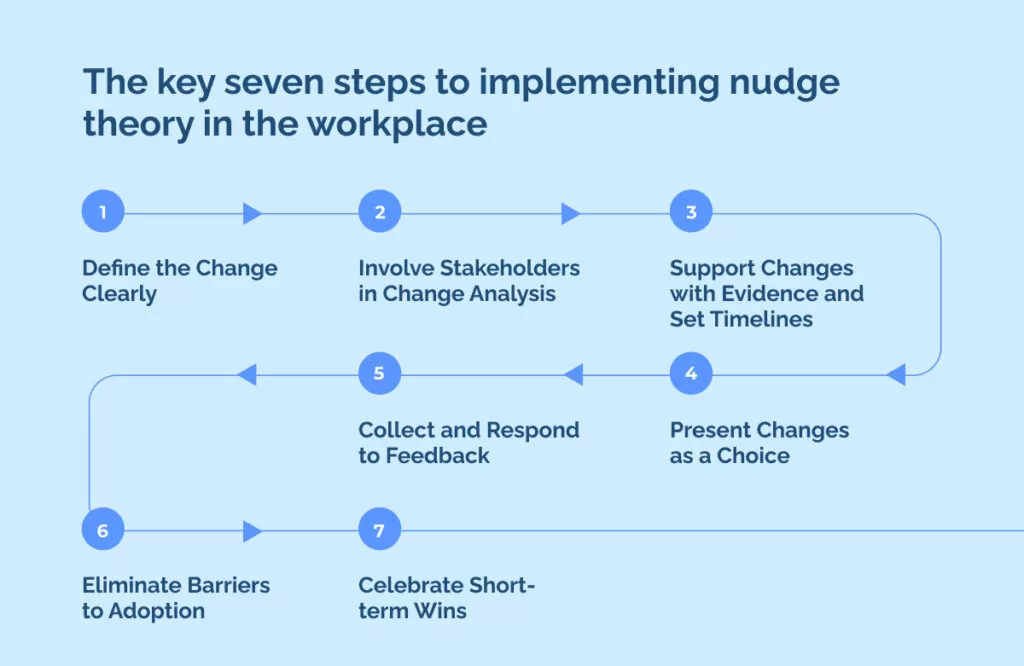
The process involves several key steps:
- Define the Change Clearly
Specify the goals and outcomes you expect from the change. For example, if transitioning to a new CRM system, outline the benefits, such as improved customer tracking or more efficient sales processes.
Next, provide enough information to ensure understanding without causing overwhelm. Break down complex changes into digestible parts.
- Involve Stakeholders in Change Analysis
Begin working directly with end-users and leaders as the change in discussions affects them and planning. This creates a sense of ownership and reduces resistance.
Encourage stakeholder feedback and suggestions, fostering a collaborative environment where everyone’s input is valued.
- Support Changes with Evidence and Set Timelines
Use empirical evidence, like case studies or internal survey results, to validate the proposed changes.
Set realistic deadlines for each phase of the change process, providing a structured timeline that stakeholders can follow.
- Present Changes as a Choice
Instead of mandating changes, provide options that guide stakeholders toward the desired outcome. This respects their autonomy and reduces pushback.
Create the choice architecture to make the preferred options more attractive and accessible.
- Collect and Respond to Feedback
Build channels for stakeholders to voice their concerns and suggestions. Regular surveys, suggestion boxes, and open forums can be effective.
Demonstrate that you value stakeholder input by acting on their feedback where possible. This builds trust and encourages continued engagement.
- Eliminate Barriers to Adoption
Understand stakeholders’ hurdles in adopting the change and work to alleviate these. For instance, provide adequate training and support if introducing a new software tool.
Simplify the transition by ensuring necessary resources and infrastructures, like compatible technology or workflow adjustments, are in place.
- Celebrate Short-term Wins
Continuously monitor the progress of the change implementation and share these achievements with the team. This could involve sharing metrics or highlighting individual or team contributions.
Show appreciation by rewarding the efforts of those who have embraced the changes. This could be through formal recognition programs, incentives, or public acknowledgment.
In applying these steps, it’s crucial to maintain transparency, encourage open communication, and be receptive to adjusting the approach based on stakeholder feedback and evolving organizational needs.
This adaptive approach ensures that the implementation of change is as smooth and effective as possible, leading to lasting positive outcomes.
However, as nudge theory can be akin to advertising, it is important to remember that it is a neutral tool that can be used to encourage both beneficial and potentially harmful behaviors, such as promoting gambling.
To apply nudge theory ethically and responsibly, certain best practices should be followed:
- Ensure Transparency in Nudges: Make it evident to the individuals being nudged. The purpose and nature of the nudge should be openly communicated.
- Preserve Choice and Autonomy: Always allow the target audience, whether customers or employees, the freedom to choose. Nudges should guide, not coerce.
- Address Underlying Issues: Use nudges as a superficial prompt and tackle more profound challenges or problems.
- Employ Nudges as Gentle Encouragement: Nudges should be used to gently steer behavior in a desired direction rather than as a tool to impose changes forcefully.
- Communicate Extensively: Highlight the reasoning behind the change, its advantages, and the objectives intended to be achieved through it.
By adhering to these tips, businesses and organizations can utilize nudge theory in a manner that is both effective and ethically sound, fostering positive behavioral changes without compromising the agency or well-being of those involved.
The future of Nudge Theory in change management
Created by Richard Thaler and Cass Sunstein, Nudge Theory posits that behavioral change, whether in others or oneself, can be achieved through motivational strategies that resonate with common human tendencies.
These strategies often leverage innate desires such as conforming to social norms. The essence of nudge theory lies in its subtle approach to influencing decisions and guiding people towards positive outcomes while maintaining their freedom to choose.
There’s a potential for negative manipulation whenever you attempt to sway people’s actions or decisions, whether through economic or psychological means. Influence that is exerted covertly, affecting individuals without their awareness of its mechanisms or intentions, can be considered underhanded.
This is because it involves shaping someone’s behavior without knowing the influencing factors or the reasons behind their effectiveness.
However, a prominent advantage of nudges, compared to other forms of influence like direct incentives, mandates, or prohibitions, is their choice preservation. Nudges offer the option to follow the suggested path or not without imposing any formal penalties for choosing otherwise.
This aspect of nudge theory is crucial in its application across various domains, from promoting healthier lifestyles to encouraging financial savings or improving educational outcomes.
WalkMe Team
WalkMe spearheaded the Digital Adoption Platform (DAP) for associations to use the maximum capacity of their advanced resources. Utilizing man-made consciousness, AI, and context-oriented direction, WalkMe adds a powerful UI layer to raise the computerized proficiency, everything being equal.



